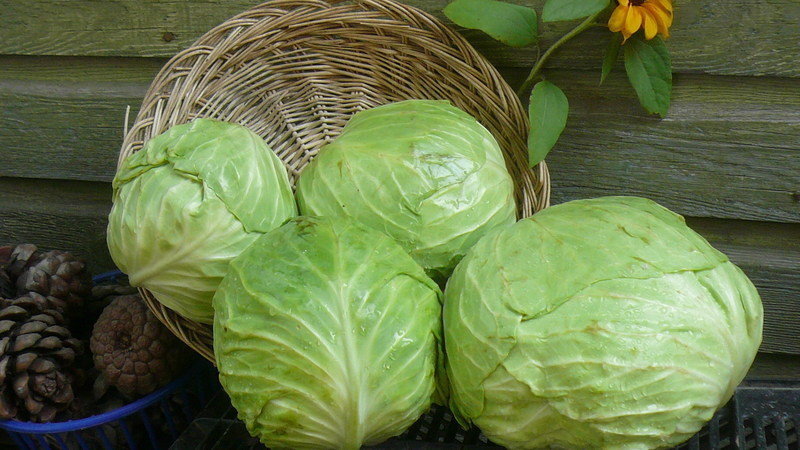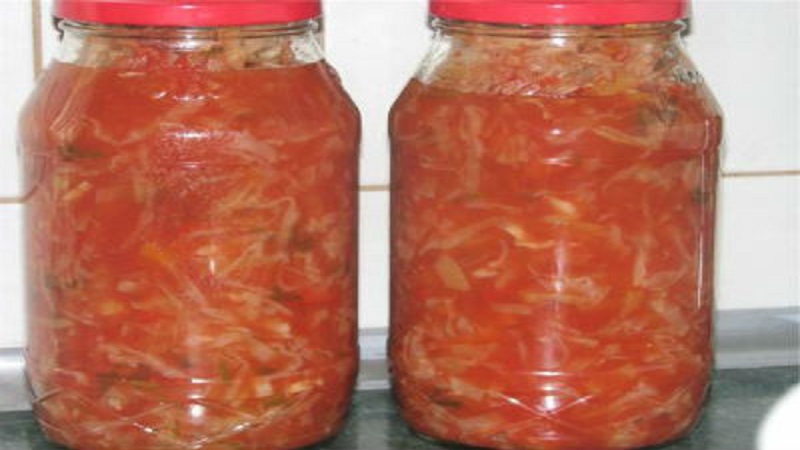The best recipes for harvesting cabbage in tomato juice for the winter without sterilization
Fresh vegetables are expensive in winter, and their quality is questionable. Cabbage in tomato juice, closed for the winter without sterilization, is a preparation of healthy and tasty products that will replace fresh vegetables in the cold season.
In the article you will find simple recipes for cooking white cabbage and cauliflower for the winter with photos blanks... Despite processing, the products retain their crunch, juiciness and nutrients.
The content of the article
Selection and preparation of cabbage for harvesting
Salting andfermentation are no longer so popular: housewives prefer to keep a maximum of useful substances in vegetables. Cabbage in tomato juice does not lose its taste and crunchiness. Such a preparation is used in the preparation of salads, borscht, or served with side dishes.
For harvesting, take a tough, strong head of mid-season cabbage - a young white cabbage is not suitable for making dressings.
If there is no ready-made tomato juice, fresh chopped tomatoes are used. Tomatoes must be of fleshy varieties. They are boiled for 15 minutes longer than the time indicated in the recipe.

How to properly pickle cabbage in tomato sauce
Pickled cabbage in tomato juice is a real magic wand for housewives. It will help you quickly cook borscht and lazy cabbage rolls or become an addition to a side dish.
Ingredients, proportions
For the preparation you will need:
- 2 kg of cabbage;
- 5 kg of tomatoes;
- 1.5 cups vegetable oil;
- 3 chili pods;
- 2 heads of garlic;
- 3 tbsp. l. salt;
- 1 tbsp. l. vinegar essence.
For cabbage preparations, large table salt is used. Extra salt and iodized salt are not suitable for processing vegetables.
Step-by-step instruction
It's easy to prepare a blank for the winter, the main thing is to prepare the vegetables and not disturb the processing order. You can do two processes at the same time - while the tomato juice is boiling, deal with cabbage.
Cabbage:
- Peel the head of cabbage from the top leaves, wash and cut into cubes.
- Put the cabbage in a saucepan, pour boiling water over and put on low heat for 5 minutes.
- Throw the leaves in a colander, and then put them in jars.
Tomato juice:
- Wash tomatoes, wipe off moisture, cut into pieces and chop in a blender.
- Rub the tomato paste through a sieve to remove skins and seeds.
- Put the resulting juice over low heat in an enamel bowl.
- Add sunflower oil and salt.
- After 30 minutes add garlic, chopped pepper and vinegar.
- After another 5 minutes, turn off the mixture and pour into the jars.
Banks are rolled up with iron lids, wrapped for a day, and then transferred to a cool place.
Recipe variations
Recipes harvesting a lot of cabbage. You can close not only white cabbage for the winter, but also cauliflower and Brussels sprouts.
Traditional recipe
To prepare according to the traditional recipe, you will need:
- 1 kg of cabbage;
- 250 ml of fresh tomato juice;
- 1 tbsp. l. salt;
- 1 bay leaf;
- 2 black peppercorns.
Step-by-step instruction:
- Remove the top leaves from the head.
- Rinse and shake off water.
- Cut the forks into 4 pieces and cut into thin strips.
- Salt.
- Boil tomato juice in a stainless or enamel bowl.
- After boiling, add bay leaf, pepper and cabbage to the juice.
- Boil the mixture for 5 minutes.
- Arrange cabbage in cooked jars, pour juice on top.
- Close cans with lids or roll up.
With tomato paste

Not every housewife has the time and resources to make tomato juice. Replace it with store-bought tomato paste.
Ingredients:
- 2 kg of cabbage;
- 1 kg of tomatoes;
- 0.5 kg of bell pepper;
- 1 cup diluted tomato paste
- 1 glass of vegetable oil;
- 2 tbsp. l. salt;
- 5 tbsp. l. Sahara;
- 40 ml of 9% vinegar;
- bay leaf and pepper to taste.
Cooking procedure:
- Chop the cabbage, chop the tomatoes and peppers.
- Pour oil into a saucepan and add tomatoes.
- As soon as the juice comes out of the tomatoes, add the pepper and simmer for 5 minutes over low heat.
- Then add the cabbage and steam covered.
- Once the cabbage has settled, add sugar, salt and vinegar to the mixture.
- Simmer the workpiece over low heat for 1.5 hours under a lid.
- Half an hour before readiness, add bay leaf, pepper and tomato paste, diluted to the consistency of a sauce, to the mixture.
- Put the mixture in jars and close the lids.
Preparation for borsch
It is simple to prepare borsch dressing, it requires:
- 1.5 kg of beets;
- medium head of cabbage;
- 0.5 kg of carrots and onions;
- 0.5 l of tomato juice;
- 90 ml 9% vinegar;
- 250 ml of vegetable oil.
Housewives put salt and spices in such a preparation according to their taste preferences.
Tomatoes are squeezed out through a juicer or passed through a sieve. The head of cabbage is chopped into small strips and placed in a saucepan or enamel bowl. The rest of the vegetables are washed, chopped, and added to the cabbage. Pour oil, tomato juice into a container, put it on fire and boil the dressing for 30 minutes. Vinegar is poured in 5 minutes before readiness. The workpiece is ready - it is distributed among sterilized cans and rolled up with tin lids.

Cauliflower in tomato sauce
Tinned cauliflower will take its rightful place next to the favorite cucumbers and tomatoes.
Required:
- 1 kg of cauliflower;
- 1 kg of tomatoes;
- 1 tbsp. l. salt;
- 1 tbsp. l. Sahara;
- 5 black peppercorns;
- 2 tbsp. l. 9% vinegar;
- some seeds if desired dill and coriander.
Cauliflower inflorescences are soaked in salt water to get rid of insects. After washing, the inflorescences are separated and dried.
Juice is squeezed out of tomatoes by stewing, rubbing through a sieve or juicer.
The inflorescences are folded into a colander and dipped in boiling water for a couple of minutes. Then the cabbage is placed under cold water for a minute. As soon as the water drains, the inflorescences are laid out in banks.
Tomato juice is put on fire and spices, sugar and salt are added. Boil for 2 minutes, add vinegar and pour cabbage with juice.

Brussels sprouts
Housewives love Brussels sprouts, as they do not need to be additionally chopped. Harvesting with such cabbage stimulates appetite, saturates the body with vitamins and nutrients.
Ingredients:
- 2 kg of Brussels sprouts;
- 1 kg of tomatoes;
- 2 bunches of celery;
- 5 pieces. carnations;
- 3 tbsp. l. salt;
- 2 liters of water.
Salt, cloves are added to the water, they are set to boil. After boiling, the water is set aside. The heads of cabbage are washed and boiled for 5-6 minutes, then cooled in cold water and allowed to drain. Tomatoes and celery are washed and chopped. Layers in an enamel pan: cabbage, tomatoes, celery. The container is poured with cooled brine, covered with a lid and placed in the refrigerator for 10 days.

Feature. Such a blank can be consumed after 10 days or placed in jars and stored in the refrigerator.
Terms and conditions of storage
Preparing a blank for the winter is only half the battle. It is important that the product does not deteriorate during storage. Many housewives keep blanks in the basement or cellar. However, not all city dwellers have this opportunity. With proper preparation, you can store jars at home - on insulated balconies, in a pantry or in a refrigerator.
The storage area should be dry, away from stove and other heat sources.
Important! If vegetables have been prepared without sterilization, store in cool conditions. The optimum temperature is + 10 ° С.
The shelf life of pickled cabbage is from several months to a year. Workpieces are stored least of all without sterilization, the longest are cans with rolled-up sealed tin lids. Storage conditions play an important role - if the temperature is violated, vegetables can turn sour.
After opening, the can lid is replaced with a nylon one. Shelf life of open blanks in the refrigerator: fermented product - 5-7 days, pickled - 3 days.
Secrets of experienced housewives
Each housewife has her own secrets of twisting and storing blanks. We bring to your attention life hacks for preparing and storing pickled cabbage:
- For blanks, it is better to take small cans - 0.5 l, 0.7 l, and 1 l. Such volumes are convenient for preparing one dish. In large cans, after opening the lid, a several-fold refueling may turn sour.
- All preparations for harvesting vegetables begin with cans - they are washed, dried and sterilized.
- It is better to use red tomatoes for the tomato filling.
- After the lids are rolled up, all cans are insulated and left for a day, then transferred to a cool place.
- Check the tightness of the lids - turn the cans upside down. If liquid begins to ooze from any can, the lid on it must be replaced.
- The curls are kept away from sunlight, otherwise the vegetables will deteriorate.
- If cloudy spots or mold appear on the surface of the cabbage, it is better not to risk your health and discard such a blank.
Conclusion
The beginning of autumn is the season for harvesting and conservation. Housewives try to close as many useful and tasty blanks as possible during this period. Cabbage in tomato juice is a healthy dish that the whole family will enjoy.
There are several recipes for pickling cabbage, they are all simple and have a similar principle. Their main advantage is the absence of sterilization, which reduces the shelf life of the product, but at the same time increases the quality and usefulness of the blanks.